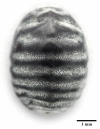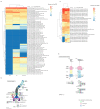Metatranscriptomic Analysis of the Bacterial Symbiont Dactylopiibacterium carminicum from the Carmine Cochineal Dactylopius coccus (Hemiptera: Coccoidea: Dactylopiidae)
- PMID: 30609847
- PMCID: PMC6463064
- DOI: 10.3390/life9010004
Metatranscriptomic Analysis of the Bacterial Symbiont Dactylopiibacterium carminicum from the Carmine Cochineal Dactylopius coccus (Hemiptera: Coccoidea: Dactylopiidae)
Abstract
The scale insect Dactylopius coccus produces high amounts of carminic acid, which has historically been used as a pigment by pre-Hispanic American cultures. Nowadays carmine is found in food, cosmetics, and textiles. Metagenomic approaches revealed that Dactylopius spp. cochineals contain two Wolbachia strains, a betaproteobacterium named Candidatus Dactylopiibacterium carminicum and Spiroplasma, in addition to different fungi. We describe here a transcriptomic analysis indicating that Dactylopiibacterium is metabolically active inside the insect host, and estimate that there are over twice as many Dactylopiibacterium cells in the hemolymph than in the gut, with even fewer in the ovary. Albeit scarce, the transcripts in the ovaries support the presence of Dactylopiibacterium in this tissue and a vertical mode of transmission. In the cochineal, Dactylopiibacterium may catabolize plant polysaccharides, and be active in carbon and nitrogen provisioning through its degradative activity and by fixing nitrogen. In most insects, nitrogen-fixing bacteria are found in the gut, but in this study they are shown to occur in the hemolymph, probably delivering essential amino acids and riboflavin to the host from nitrogen substrates derived from nitrogen fixation.
Keywords: Opuntia; betaproteobacteria; endosymbiont; nitrogen-fixation: gut microbiota; polysaccharide catabolism; scale insect.
Conflict of interest statement
All the authors declare no conflict of interest associated with this study that might potentially bias this work.
Figures






Similar articles
-
Functional genomics of a Spiroplasma associated with the carmine cochineals Dactylopius coccus and Dactylopius opuntiae.BMC Genomics. 2021 Apr 6;22(1):240. doi: 10.1186/s12864-021-07540-2. BMC Genomics. 2021. PMID: 33823812 Free PMC article.
-
Candidatus Dactylopiibacterium carminicum, a Nitrogen-Fixing Symbiont of Dactylopius Cochineal Insects (Hemiptera: Coccoidea: Dactylopiidae).Genome Biol Evol. 2017 Sep 1;9(9):2237-2250. doi: 10.1093/gbe/evx156. Genome Biol Evol. 2017. PMID: 30605507 Free PMC article.
-
Comparative genomics of the carmine cochineal symbiont Candidatus Dactylopiibacterium carminicum reveals possible protection to the host against viruses via CRISPR/Cas.Syst Appl Microbiol. 2024 Sep;47(5):126540. doi: 10.1016/j.syapm.2024.126540. Epub 2024 Jul 20. Syst Appl Microbiol. 2024. PMID: 39068732
-
The Use of Insect Pigment in Art Works.Insects. 2024 Jul 10;15(7):519. doi: 10.3390/insects15070519. Insects. 2024. PMID: 39057252 Free PMC article. Review.
-
[Asthma and allergy due to carmine dye].An Sist Sanit Navar. 2003;26 Suppl 2:65-73. An Sist Sanit Navar. 2003. PMID: 13679965 Review. Spanish.
Cited by
-
Transcriptomic Responses of Rhizobium phaseoli to Root Exudates Reflect Its Capacity to Colonize Maize and Common Bean in an Intercropping System.Front Microbiol. 2021 Oct 28;12:740818. doi: 10.3389/fmicb.2021.740818. eCollection 2021. Front Microbiol. 2021. PMID: 34777287 Free PMC article.
-
Insight into the bacterial communities of the subterranean aphid Anoecia corni.PLoS One. 2021 Aug 11;16(8):e0256019. doi: 10.1371/journal.pone.0256019. eCollection 2021. PLoS One. 2021. PMID: 34379678 Free PMC article.
-
RNAi-induced knockdown of white gene in the southern green stink bug (Nezara viridula L.).Sci Rep. 2022 Jun 21;12(1):10396. doi: 10.1038/s41598-022-14620-0. Sci Rep. 2022. PMID: 35729244 Free PMC article.
-
On the Origins of Symbiotic Fungi in Carmine Cochineals and Their Function in the Digestion of Plant Polysaccharides.Insects. 2024 Oct 9;15(10):783. doi: 10.3390/insects15100783. Insects. 2024. PMID: 39452359 Free PMC article.
-
Functional genomics of a Spiroplasma associated with the carmine cochineals Dactylopius coccus and Dactylopius opuntiae.BMC Genomics. 2021 Apr 6;22(1):240. doi: 10.1186/s12864-021-07540-2. BMC Genomics. 2021. PMID: 33823812 Free PMC article.
References
-
- Rosenblueth M., Martínez-Romero J., Ramírez-Puebla S.T., Vera-Ponce de León A., Rosas-Pérez T., Bustamante-Brito R., Rincón-Rosales R., Martínez-Romero E. Endosymbiotic microorganisms of scale insects. TIP Revista Especializada en Ciencias Químico-Biológicas. 2018;21:53–69. doi: 10.1016/j.recqb.2017.08.006. - DOI
-
- Morrison J.F. Master’s Thesis, Master of Science. Rhodes University; Grahamstown, South Africa: Jan, 1984. Protection from Beetle-Predation in Cochineal Insects (Dactylopiidae: Homoptera)
Grants and funding
LinkOut - more resources
Full Text Sources
Miscellaneous

